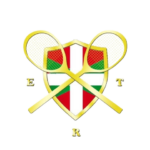
JEU DE PAUME BAYONNE PAYS BASQUE
Euskal Real Tennis
JEU DE PAUME
BAYONNE - PAYS BASQUE
Euskal Real Tennis
The Main Rules
The game of real-tennis is played in singles or doubles.
The points in a game are counted in 15, 30, 40, 40 All, advantage, game (as in tennis). The match is won in 3 or 5 sets of 6 winning games.
Players can take the ball either after a bounce on the ground or on the volley to return it to the other side of the net.
The ball can bounce an unlimited number of times on the 4 walls within the boundaries of the court and on the court penthouses.
The service : The service : Unlike modern tennis, the serve is always done from the same side: the dedans side or end. The other side of the net is called the hazard side or hazard end. The ball must bounce at least once on the penthouse on the hazard end (after the net) and must land in the service square marked out on the ground. The server is entitled to 2 service balls.
The receiving player (hazard end) recovers the service when he changes over to the dedans end. This change (crossover) is made when one of the 2 players is at 40 and a chase is in play, or when there are 2 chases in play. Players can, during the same game, lose or gain the service and therefore change dedans/hazard ends several times, depending on the number of chases in play.
Sayings that originate from the real-tennis game:
Sayings
that originate from the real-tennis game:
The game of real-tennis gave birth to specific expressions and some have spanned the centuries. They refer to different phases of the game, different techniques and strategies taking place during the game. Reflecting the complexity and finesse of the game, they are often confusing for novices. Here are some examples:
The chase :
The chase is a “suspended” point.
This suspended point is brought back into play when the players change sides.
The chase occurs when the ball falls, on its second bounce, on the opposing side of the net in the areas designated by a line drawn on the ground connected to a number (2, 4, 6,…) or a letter (D, S,…) which is written on the wall.
When the players change sides, the point is put back into play and the playing area to win the point is reduced to the area between the line where the ball made its second bounce and the back of the court.
The ball put into play must not make a second bounce outside this reduced zone of play, otherwise the point goes to the opponent.
Volley the ball: A sign of the player's great liveliness, this expression is used in modern language to designate the “lively spirit” of a player.
He who imposes a chase … loses his place: Le dedans (serving side) being the most advantageous for scoring points, when the players change sides (due to the chase), the server will try to recover the suspended chase point(s), though by doing this, he may lose the advantageous position he had.
The ball falls on the nick: When the 2nd bounce arrives exactly in the angle where the floor meets the dedans wall, this chase is called, by the referee, as “better than half a yard, or informally called “chase nick”. This particular chase is the most difficult to play as it can only be won by playing the ball into the gallery net on the dedans side.
Left on the square: When the player falls while trying to hit the ball or when he loses the game, he is said to be "left on the square", the floor of real tennis courts being, originally, covered with tiles.
Impressing the galleries: The galleries are the netted open spaces under the penthouses surrounding the real tennis court. These areas are where the spectators stand. The gallery gets excited when the level of the game arouses jaw-dropping admiration!
A hand game, a villain’s game: In the Middle Ages, only the rich could afford rackets to protect their hands, while the poor (the villains) played with bare hands.
Tripot: The tripot is the original name of the real tennis court. An indoor place present in many cities, it was once an ideal place for betting and other games of bad reputation. However, during the 17th century the term “gamble” became pejorative.
To have the advantage: When the players are 40/40 (deuce), the one who wins the next point is one point away from winning the game: So he has the advantage to win.
Bisque, bisque, rage! : A “bisque” is a “winning point” from which the player can benefit once in the game at the time of his choice. This is a "joker" which really angers the opponent when it is used.
Peloter: Peloter is the pleasure of playing without counting points, often before the game itself. This verb has passed into colloquial language as a reference to people flirting with one another.
The children of the ball: As the real tennis halls were also used as theatres,the actors’ children were called "the children of the ball", just like the children of the master professionals in that period of time.